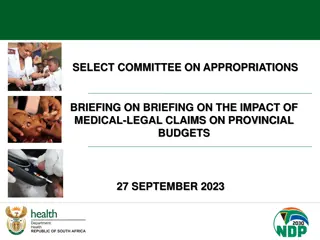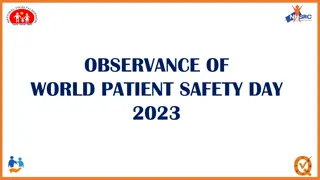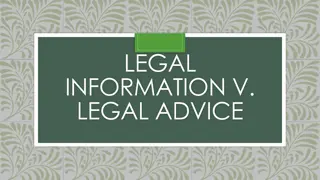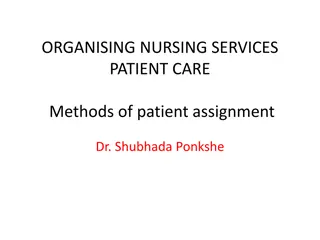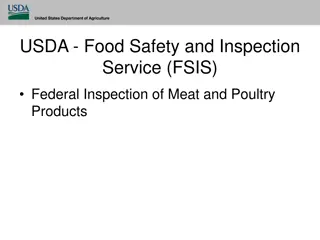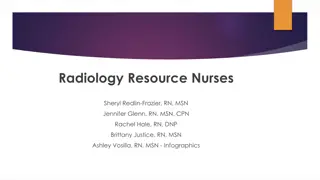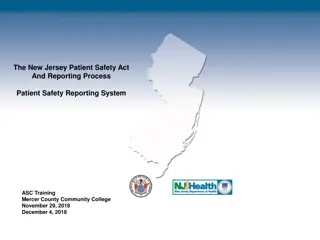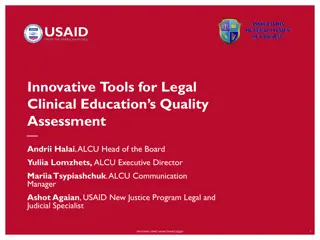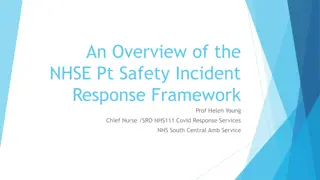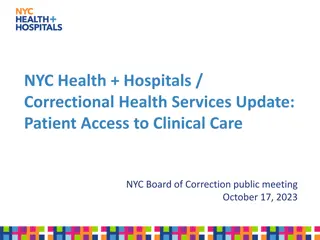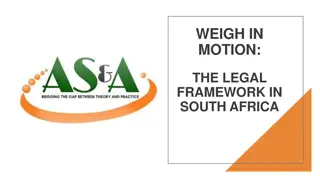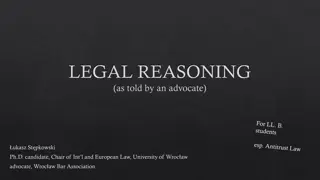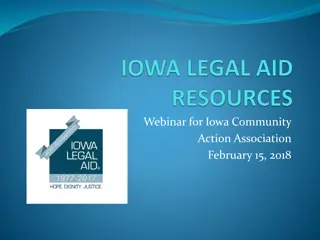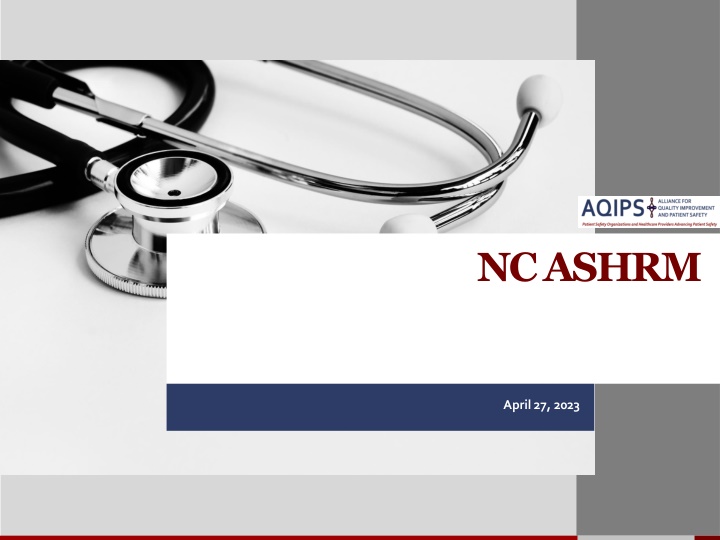
Legal Overview of Patient Safety Act
Patient Safety Act establishes Federal protections for healthcare provider information, aiming to close gaps in peer review statutes and promote data sharing while safeguarding confidentiality. The Act focuses on privilege objections, PSES establishment, peer protections, and provider analysis.
Download Presentation

Please find below an Image/Link to download the presentation.
The content on the website is provided AS IS for your information and personal use only. It may not be sold, licensed, or shared on other websites without obtaining consent from the author. If you encounter any issues during the download, it is possible that the publisher has removed the file from their server.
You are allowed to download the files provided on this website for personal or commercial use, subject to the condition that they are used lawfully. All files are the property of their respective owners.
The content on the website is provided AS IS for your information and personal use only. It may not be sold, licensed, or shared on other websites without obtaining consent from the author.
E N D
Presentation Transcript
NC ASHRM April 27, 2023
Patient Safety Act Plaintiffs argue that the PSWP privilege objection is boilerplate because Section 299b-22 is a now in-vogue objection by healthcare providers; however, it is technical and in my experience is referred to by healthcare providers but not actually complied with in practice and is thus inapplicable in most cases.
Patient Safety Act Fundamentals While the Patient Safety Act does establish new Federal confidentiality and privilege protections for certain information, these protections only apply when healthcare providers work with a PSO and new processes, such as a patient safety evaluation systems, that do not currently exist. (See Final Rule, 73 Fed. Reg.70795 (Nov.21, 2008). Tools to establish a strong PSES for the privilege to attach: PSO Industry Standard PSES + diagrams PSQIA Treatise
The Patient Safety Act was Intended to Close the Gaps/Erosion of State Peer Review Statutes by Establishing National Peer Protections. The Patient Safety Act provides standard minimum peer protections across all states, that apply to all licensed providers and authorized persons in state court (malpractice and premises liability [visitors], workforce violence [providers]), and Federal Court, including ADA employment cases to permit healthcare providers to talk to each other.
The Patient Safety Act is a Disclosure Statute These protections will enable providers, including multi-facility health care systems to share data within a protected legal environment, both within and across states, without the threat of information being used against the subject providers. Id. The privilege and confidentiality sections are separate to block waiver and the PSQIA includes express no waiver through disclosure and no opening the door clauses (42 U.S.C. 299b- 22(d)).
Real Benefit of the PSQIA is Provider Deliberations and Analysis The PSQIA states that protected analysis may be developed in the provider PSES. (See 42 USC 299b- 22(h)). The rulemaking provides that Provider s needs dictate which patient safety activities will be conducted within their respective PSES and which will be assigned to the PSO. Final Rule, 73 Fed. Reg. at 70746. The law and rule are intended to enable health care providers to protect their internal deliberations and analysis of patient safety information because this type of information is patient safety work product. Proposed Rule, 73 Fed. Reg. at 8113.
Types of Benefit Scope of the PSQIA is any effort to improve patient safety or the quality of patient care delivery Examples: Can protect peer review and peer-to-peer programs. UNC confidential peer support for healthcare professionals HCA service line collaboratives (including contract physicians) Internal safe-tables with EMS/clinical contractors (medical groups) Reviewing recordings for quality (surgery, falls, Trauma recordings, etc. ) Sharing of best practices and safe-tables with other health systems (e.g., transfers)
3 Protections for Protected Information (PSWP)
3 PSQIA Protections for Patient Safety Work Product PSOs cannot be compelled for PSWP (immune from suit) - Plaintiffs have the burden of proving information is not privileged or confidential (42 U.S.C. 299b-22(d)(4)). Privilege PSWP is privileged. (42 U.S.C. 299b- 22(a)). Confidentiality Privacy rights for Providers (to have confidential conversations/safe-tables)/PSWP is confidential. (42 U.S.C. 299b-22(b)). Each section of the law has its own case law.
We have state law protections - We don t need the PSO Protections The PSQIA is the most extensive piece of tort reform ever passed by Congress. The PSQIA expressly preempts Federal guidance, state laws and court orders that are inconsistent with the PSQIA. The PSQIA protections are stronger and broader than any state law. The state and federal privileges that are consistent can be stacked to provide an additional defense. Cannot protect information in Federal ADA cases, no defense in criminal negligence cases and if CMS gives it to the plaintiff s bar under subpoena/FOIA.
Case Law Confidentiality November 8, 2022
PSWP is Confidential Taylor v. Hy-Vee, 2016 U.S. Dist. LEXIS 177764 (D. Kan., 12/22/16). Once information is PSWP what a pharmacy ultimately does with data collected and reported to a PSO is not relevant. Such data is designated as PSWP by 42 U.S.C. 299b-21(7)(A) and there is nothing in the PSQIA to suggest that data can lose that designation. TAKE AWAY: Privilege cannot be waived. Wantou v. Walmart Stores, Inc., No. 5:17CV18-RWS-CMS, Under the PSQIA, anyone to whom PSWP is disclosed, permissibly or impermissibly, becomes a responsible person required to keep PSWP confidential. PSWP that is disclosed remains privileged and confidential and cannot be used as evidence. TAKE AWAY: Use the confidentiality provisions with the privilege. 3 Cases where Department of Health/Pharmacy Board takes PSWP and gives it to plaintiff s lawyers through subpoena or FOIA. Courts uphold the privilege when providers can show the information is PSWP (marked PSWP). If the government takes PSWP mark it as PSWP and give the surveyors a confidentiality agreement to sign to demonstrate they understand it is PSWP.
3 Pathways to Create Protected Information (PSWP)
What is Patient Safety Work Product? The Patient Safety Act Privilege and Confidentiality protections apply to information developed by the PSO or by a provider using the new process, such as the Patient Safety Evaluation Systems. PSWP May include the following information Data, reports, records, memoranda, analysis (including root cause analysis) or written or oral statements. Information with respect to improving patient safety, such as recommendations, protocols, or information regarding best practices Information incudes Feedback from the PSO or Provider PSES (see definition of Patient Safety Activities) Must meet one of three mutually exclusive processes Reporting Process 42 U.S,C. 299b- 21(7)(a)(i)(A) Assembled or developed by a provider (solely) for reporting to a PSO and are reported to the PSO and either: (a) are reported to the PSO or (b) Currently exists in the PSES with the intention of reporting to the PSO (the date of reporting into the PSES must be documented). And which could result in improved patient safety, healthcare quality, or healthcare outcomes. PSO Process 42 U.S.C. 299b- 21(7)(a)(i)(B) Collected (trigger tool) or Developed by a PSO for the conduct of patient safety activities (by the PSO or by the Provider within the PSES) and which could result in improved patient safety, healthcare quality, or healthcare outcomes. Analysis Process (used by both the PSO and Provider) 42 U.S.C. 299b- 21(7)(a)(ii) Information that identifies or constitutes the analysis of, or identify the fact of reporting pursuant to, a patient safety evaluation system. Parts of medical records (e.g., information about falls compiled on a spread sheet) can be PSWP if it serves as a roadmap to identify analysis. Quality Audit Trails in electronic medical records can also be PSWP as they identify quality analysis.) 14
Patient Safety Evaluation System: New Process in Policies and Procedures Definition of PSES must be read with the definition of Patient Safety Activities and the definition of PSWP. PSES is the system that permits the collection, analysis and deliberation, use and disclosure. storage of PSWP throughout a legal healthcare entity.
Patient Safety Evaluation System for Event Report and Investigation Report to PSO Investigation Interviews Adverse event or near miss occurs RCA/ Causal Analysis (Could be Round Robin PSES Program) Analysis of PSO Feedback Corrective Actions Identified Results back to clinician Committee Review System causal factors addressed Collaborative M&M Disclosure/Medical Group Safe table Org. learning occurs and sharing with other PSOs/providers Lesson-learned disclosure Disclose to PSO
Case Law: Reporting Pathway Unsettled Case Law/Differs by State
Case Law under Reporting Pathway Majority of case law is under this pathway. Lots of confusion on what is protected/a great deal of bad case law HHS intentionally created much of the confusion with its 2016 Guidance. DOJ (HHS Lawyers) Overturned 2016 Guidance inconsistent with the PSQIA and regulations. (The 2016 guidance only applied to the reporting pathway and is void.) Plaintiff s lawyers cite 2016 guidance and Charles (FLA Supreme Court) to say that any information must be collected for the sole purpose of reporting to the PSO (e.g., to meet state record-keeping requirement) is information that is separate from the Patient Safety Evaluation System (i.e., not protected Patient Safety Work Product). Charles has been narrowed and have very limited precedential value. Some lawyers combine the Reporting and Analysis pathway. Courts will protect analysis and deliberations that occur in the PSES prior to reporting. UK v. Bunnell (analysis included in event report) and New case. Xxx (safety huddles and interviews that occurred in PSES are protected without reporting and no deposition of nurse who learned of the incident in the PSES. Interview notes were reported to the PSO as no event report was reported to the PSO)
TMH v. Wiles The case reviewed whether an event report prepared for reporting and was reported to the PSO that is also maintained in the state recordkeeping system was Privileged and Confidential in the malpractice case. The Court concluded that the report is privileged and confidential under the Patient Safety and Quality Improvement Act of 2005, which preempts the reports compelled disclosure under Amendment 7. In Charles II, the Florida Supreme Court held that any document that may potentially be reported pursuant to state record keeping and reporting must exist separately from the patient safety evaluation system and therefore cannot be PSWP and is subject to Amendment 7 (patient s right to know). TMH paints Charles into a corner. Tallahassee Memorial Healthcare, Inc. v. Lennox Wiles, a minor, by and through his parents and natural guardians, Jade Wiles and Justin Wiles, and Jade Wiles and Justin Willes, individually, No. 1D21-1503 (1st Dist. App. Fl., November 14, 2022).
Implications of the Florida TMH v. Wiles Case After Charles II, Plaintiff lawyers in several states said PSQIA applies on a state-by-state basis (no preemptive effect). Not limited to information created solely for reporting to the PSO. Providers enjoy National protections for PSWP. Status of the case: The court also certified its conclusions for review by the Florida Supreme Court. The First District denied the motion for rehearing on December 27. The plaintiff filed a notice to invoke the jurisdiction of the FLA Supreme Court.
Case Law: Deliberations and Analysis Pathway Limited Case Law/Plaintiff s settle
Analysis Pathway Rumsey v. Guthrie (MD Pa. 2019). PSQIA extends privilege protections to deliberations and analysis conducted within a PSES: The proceedings and minutes of infection control meetings conducted within a PSES. PSO work product shared with providers: Infection control and prevention materials received from PSO. Hacking v. United States (S.D. FLA, April 28, 2021). After in camera review, court determined that an RCA that had not been reported to the Hospital s PSO constituted privileged PSWP under the deliberations and analysis pathway.
Practice Pointers The reporting pathway has weaknesses. Only use the reporting pathway for information that is taken from the treatment area (use for incident reports and recordings). Information that is analysis or deliberations created within the PSES has strong protections protect it under the analysis pathway. If your provider has not reported the facts in an incident report the facts will not be protected in an analysis report. This is why providers get trapped into reporting analysis (meeting minutes) and lose in states that require the information to be collected solely for reporting to the PSO. If your provider will not report incidents to a PSO they should have their own PSO to avoid creating muddy water case law.
Know the PSWP Disclosures Use the PSQIA does not limit uses. PSWP can be used for any purpose through out a legal entity and remain privileged and confidential (NO WAIVER). Disclosure release, transfer, provision of access to, or divulging in any other manner of PSWP by a person holding PSWP to another person outside of the legal entity. Permissible Disclosure to healthcare providers or professionals; to PSO; if all providers identified in the PSWP agree; to outside counsel. PSWP protections reattach after disclosure (NO WAIVER). Voluntary Disclosure of nonidentifiable PSWP - can lose its protections if it is desired by the disclosing party. Cannot be forced to disclose nonidentifiable PSWP. Impermissible Disclosure disclosure in violation of the confidentiality provisions can result in an OCR investigation and fine, similar to HIPAA, BUT DOES NOT WAIVE THE PROTECTIONS. 25
Disclosures of PSWP Should NOT be Reported to the PSO PSWP is already privileged and confidential it does not need to be reported upon disclosure for patient safety activities (learning or further analysis). Disclosing PSWP for patient safety activities (learning or further analysis) does not waive the privilege or confidentiality provisions. PSWP analysis or feedback is not reported to the PSO, if it is shared with the PSO to be distributed to the learning system it is disclosed to the PSO under a permissible disclosure permission. 26
PSWP Privileged in Criminal Proceedings In most states, peer protections do not extend to criminal proceedings. Patient Safety Work Product privilege and confidentiality protections apply re: discovery and use as evidence in criminal proceedings, unless an exception applies (42 USC 299b-22(a) and (b)). The PSA was not intended to hide criminal behavior but was intended to protect patient safety and quality related event information to encourage a safety culture. Congress believed that PSOs may be able to identify crimes such as an angel of death killing patients in multiple hospitals (NJ 2000). Congress also believed that criminal negligence claims could be used to circumvent the PSQIA protections because all errors that result in harm could be considered criminal negligence. Add a footer 27
Just Culture with Law Enforcement Overlay Reckless Knowing Intentional Human - Error At-Risk Behavior Unintended conduct: should have done other than what they did or would have happened to anyone Conscious disregard of a substantial and unjustifiable risk of harm/ Knowing or intending to cause harm A choice where risk is not recognized, or is mistakenly believed to be justified Accept Coach Sanction Crime Criminal Negligence with Injury
Exception from Confidentiality: Disclosures to Law Enforcement Voluntary disclosure to law enforcement related to the commission of a crime. The provider must have a reasonable belief under the circumstances that a crime was committed and believes the information is necessary for criminal law enforcement purposes. 42 CFR 3.206(b)(10). 29
Law Enforcement Disclosure Determination Who is law enforcement? Regulatory agencies (other than DEA) are not law enforcement. The decision about whether it is reasonable to believe a crime has been committed is the discloser s decision alone (Proposed Rule at 8152) (The provider can decide that a human error that caused harm is not a crime.) The discloser should not rely solely on a law enforcement agent s statement that such information is necessary for law enforcement purposes (Proposed Rule at 8152.) This disclosure has been used in cases of sexual assault. Have the law enforcement personal sign a confidentiality agreement that identifies the PSWP and clearly mark the PSWP - PSWP Confidential. Privileged under the Patient Safety and Quality Improvement Act of 2005. 30
Law Enforcement Disclosure The disclosed PSWP remains privileged and confidential after disclosure and the privilege and confidentiality cannot be waived. 42 USC 299b-22(c)(1). Can use PSWP to pursue any law enforcement purpose and can only disclose the PSWP to other law enforcement entities as needed for law enforcement activities related to the event that gave rise to the disclosure. (70785) Disclosure under this section does not except the privilege. Thus, PSWP cannot be subpoenaed, ordered or entered into evidence in a criminal or civil proceeding through this exception to confidentiality. (8150). OCR 31
Exception from Confidentiality & Privilege for Disclosure in Criminal Proceeding If a provider is charged/indicted PSWP can be disclosed for use in a criminal proceeding but only after a judge has determined through in-camera review that the patient safety work product sought for disclosure: Contains evidence of a criminal act, Is material to a criminal proceeding, and, Is not reasonably available from any other source. If these elements are met, the exception to confidentiality and privilege apply only in this case (42 USC 299b-22(c)(1)(a); 42 USC 204(b)(1)) and the PSWP loses its protection. The information is available to be used in a civil proceeding. 32
Take Aways Patient Safety Act protects the internal investigation/analysis that was conducted for learning. If the provider does not believe the PSWP contains evidence of a criminal act, the criminal justice system must conduct its own investigation to prove its case. If peers believed a criminal act occurred, they can confidentially alert the PSO and disclose PSWP to law enforcement. Gives an opportunity for peers to opine that they believe no criminal act occurred in human error or at-risk behavior. This should be a clue to the criminal investigators. The Patient Safety Act gives a defense in court for peers to say no criminal act occurred or to explain systems errors as the proximate cause. 33
Questions Peggy Binzer Pbinzer@aqips.org 703.581.9285 www.AQIPS.org 34


